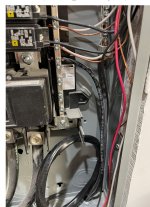Alwayslearningelec
Senior Member
- Location
- NJ
- Occupation
- Estimator
Residential panel. How do you know which is the ground bar and which id the neutral bar. They both have a black cable attached to them( ignore the large black cable, that's for a future load) leaving the bottom of the panel. I assume one of those black cables goes to a ground rod.
Can you really have grounds and neutral attached to the same terminal/bar as you see? Thanks.
Can you really have grounds and neutral attached to the same terminal/bar as you see? Thanks.



